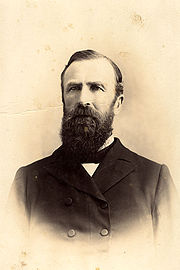
Ole Andres Olsen
Encyclopedia

Ole Andres Olsen was a Seventh-day Adventist
Seventh-day Adventist Church
The Seventh-day Adventist Church is a Protestant Christian denomination distinguished by its observance of Saturday, the original seventh day of the Judeo-Christian week, as the Sabbath, and by its emphasis on the imminent second coming of Jesus Christ...
minister and administrator. He was General Conference
General Conference of Seventh-day Adventists
The General Conference of Seventh-day Adventists is the governing organization of the Seventh-day Adventist Church. It is located in Silver Spring, Maryland, United States, where it moved in 1989...
president from 1888 to 1897.
Born in Soken, near Christiania
Oslo
Oslo is a municipality, as well as the capital and most populous city in Norway. As a municipality , it was established on 1 January 1838. Founded around 1048 by King Harald III of Norway, the city was largely destroyed by fire in 1624. The city was moved under the reign of Denmark–Norway's King...
, Norway, Olsen emigrated to the United States to Wisconsin
Wisconsin
Wisconsin is a U.S. state located in the north-central United States and is part of the Midwest. It is bordered by Minnesota to the west, Iowa to the southwest, Illinois to the south, Lake Michigan to the east, Michigan to the northeast, and Lake Superior to the north. Wisconsin's capital is...
at the age of 5. By the age of 9 his parents had begun to keep the seventh-day Sabbath. He was baptized in 1858.
From 1876 to 1877 he attended school at Battle Creek College (now Andrews University
Andrews University
Andrews University is a Seventh-day Adventist university in Berrien Springs, Michigan, United States. Founded in 1874 as Battle Creek College in Battle Creek, Michigan, it was the first higher education facility started by Seventh-day Adventists, and is the flagship university of the Seventh-day...
). In 1869 the Wisconsin Conference granted him a ministerial license. On June 2, 1873, he was ordained as a minister. The following year he was elected president of the Wisconsin Conference. He served in a variety of administrative posts.
At the 1888 General Conference session
1888 Minneapolis General Conference
The 1888 Minneapolis General Conference Session was a meeting of the General Conference of Seventh-day Adventists held in Minneapolis, Minnesota in October of 1888. It is regarded as a landmark event in the history of the Seventh-day Adventist Church. Key participants were Alonzo T. Jones, Ellet J....
he was elected General Conference president. Olsen was one of the first individuals to advocate the formation of Union Conferences. After he was not reelected as church president (1897) he went as a missionary to South Africa. In 1901 he was asked to head the work in Great Britain.
Olsen died of a heart attack
Myocardial infarction
Myocardial infarction or acute myocardial infarction , commonly known as a heart attack, results from the interruption of blood supply to a part of the heart, causing heart cells to die...
on January 29, 1915.
1888 - 1897, The Olsen Presidency
The 1888 General Conference Session elected Olsen as president. However, he was in Europe at the time and did not take on the presidency until May of 1889. The 1889 General Conference session, held in October, gave Olsen the opportunity to bring about changes and development. His opening address set the pace. Olsen's objectives included everyday administrative concerns as well a major shifting of structure and practices:Europe: Adventist literature should be translated into the Russian and Spanish languages. There should be more translation of such literature into German. Establish laborers in Turkey, France, Italy, Austria, Holland and Spain. Believers in Scandinavia want, and should have, schools established.
Australasia: The Australasian Conference needed a business manager so the leader, Tenny, could do more editing and conference work. Daniells, in New Zealand, needed an assistant. The canvassing work was getting started there and needed to be put on a business footing.
South Africa: For South Africa, a Dutch laborer should go back with Wessels to work among the people of that nationality. There should be tracts in the Kaffir language.
The United States: The work in the Southern United States needed attention. Olsen believed that canvassing, or book sales, would be the most successful type of work in the early years of the work there. Missions in the big American cities should get special help. The Bible school in Chicago deserved the conference's support. In 1889, three Colleges existed to serve the church: Battle Creek in Michigan, South Lancaster in Massachusetts, and Healdsburg in California. Careful consideration should be given to a college in the Mid-West. Olsen recommended that the work in the United States be divided into districts with each one being under the supervision of a member of the General Conference committee. This district superintendent would plan the institutes, camp-meetings, general meetings and other work for the territory. (Olsen, 1889, p. 8) As the meetings progressed, Olsen's recommendation on this became a reality.
Training Institutes: There should be special time-limited schools established for the training of ministers, the teaching of the Scandinavian, French and German languages in the United States. Most of these schools were slated to begin in November of 1889. Yet, everything that has been started should be improved upon.
Religious Liberty: The recently established National Religious Liberty Association should receive the General Conference Session's endorsement. The GC Session should also develop a plan for circulating Religious Liberty petitions.
These initiatives demonstrate Olsen's comprehensive involvement with the world church.
See also
- History of the Seventh-day Adventist ChurchHistory of the Seventh-day Adventist ChurchThe Seventh-day Adventist Church had its roots in the Millerite movement of the 1830s and 1840s, during the period of the Second Great Awakening, and was officially founded in 1863. Prominent figures in the early church included Hiram Edson, James Springer White and his wife Ellen G. White, Joseph...

